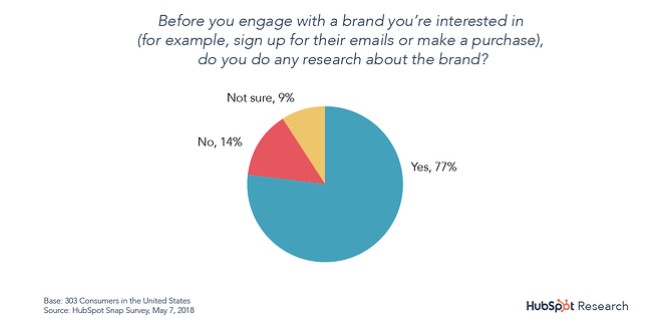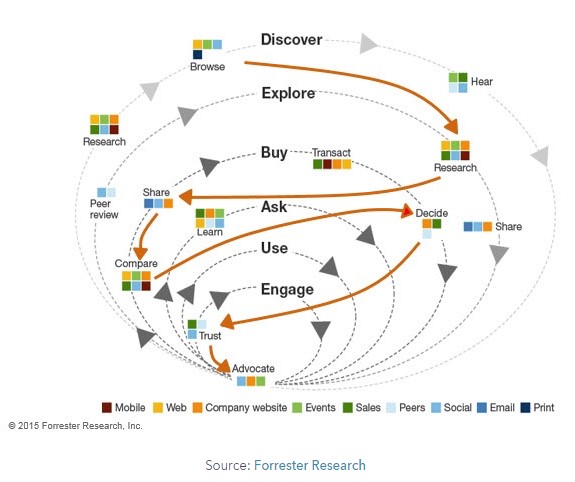All you need to know about SEO in 2019
SEO (Search Engine Optimization) is a set of guidelines used by Google to determine the quality of a website and improve its ranking in search results.

SEO: Complete Guide For Your Website To Have More Online Visibility
What is the first thing you do when you need to find out where to buy something? Or when you have any questions about how to do any kind of task?
Our guess: you ask for Google.
Just like you, 89% of B2B buyers and 81% of online shoppers do the same.
Google has long been the digital almanac of all things, the oracle that helps us when we have a question or we are looking for a solution.
And because of this general behavior is that without any presence at Google, it is unlikely that your business will survive for long.
But creating a website it’s not enough, it needs to appear among the thousands of other pages that the Internet houses.
So we have prepared this guide in which you will discover a strategy to improve your online presence.
You’ll learn what SEO is, how it works, and what you should do to improve your site’s positioning in search results.
What is SEO?
Basically, SEO is a set of strategies focused on increasing the visibility of a company in organic search results.
It helps companies and professionals rank more pages on SERPs (search engine result pages) and in turn drive more visitors to the site, increasing the chances of conversions.
In short, SEO drives two things: ranking and visibility.
Ranking
The process that search engines use to determine at which position of search results to place a web page.
Visibility
Shows how relevant a site is to search results. If it appears in the first positions, its relevance and therefore its visibility is high.
These two factors are responsible for the main SEO goals: traffic and conversions.
Nowadays, in the place of any other marketing channels, people prefer to use search engines to find products or services.
For example, in recent research, HubSpot Research found that 77% of people search for a brand before getting involved with it.

Forrester revealed that 60% of customers do not want interaction with vendors, 68% prefer to research on their own and 62% have developed their own criteria to select the right vendor.
Moreover, this process has never been so complicated.

How does Google know how to rank a page?
Search engines have only one purpose: to provide users with the most relevant answers and information for their search.
Every time you ask something to Google, its algorithms choose the pages that are most relevant to your query.
To provide the right information, search engines analyze two factors:
- Relevance between the search done and the content of a page.
- Authority of the site. Google assumes that the more popular a page, the more valuable its content is to readers.
And to analyze all this data, complex search algorithms come into play.
We refer to them as ranking factors, and they are the focus of an SEO strategy.
3 Key Elements of an SEO Strategy
To optimize a website for SEO, you need to improve the ranking factors in three areas: technical website setup, content and links.
1. Technical setup
For your website to get a good positioning, three things should happen:
- A search engine needs to find your page.
- Then it should be able to read your topics and identify your keywords.
- Finally, it need to add it to its index, a database of all content found on the web.
There is only one problem. You see a site as a collection of graphics, colors, texts and links. But for a search engine, there is nothing but text.
As a result, all elements that can not be rendered in this way remain invisible to Google and other search engines.
This is where the technical configuration, also called site optimization, comes in.
It ensures that your site and pages can be scan and indexed smoothly.
The most important factors for good optimization are:
Website navigation and links
Search engines crawl sites like you would. They follow links. They come to a page and use links to find other content to analyze. But as you saw above, they can not see images. Therefore, set navigation and links only as text.
Simple URL structure
If possible, keep your URLs short. Configure them to include as few words as possible beyond the primary keyword for which you want to optimize the page.
Page speed
The loading time of a page counts as a quality indicator. Many elements of the site can determine this factor, such as large and heavy images. Use the Google Page Speed Insights tool for suggestions on how to improve the speed of your site’s uploading.
Inactive links or broken redirects
An inactive link sends a visitor to a non-existent page. A broken redirect points to a feature that may no longer be there. Both provide a poor user experience, which is a downside to SEO.
Sitemap and Robots.txt
A sitemap is a simple file that lists all the URLs on your site. Search engines do this to identify which pages to crawl and index. A robots.txt file tells search engines which content should not be indexed (pages you do not want to appear in the search). Configure both so that they help speed up crawling and indexing of your site.
2. Content
Every time you use a search engine, you are looking for content.
This content can have different formats, such as text, video, reviews, lists, etc.
But in short, everything is content and for SEO this is what counts for your site to get more visibility in search results.
Keyword Research
The content optimization process begins with the definition of keywords and phrases that your potential buyers enter into the search engines.
To make this definition, you must first identify the terms and topics relevant to your business.
You need to think about how your audience would look for the solution you offer. For example, if you sell online math courses, your prospect is likely to do a Google search by typing terms such as “math classes,” “math courses,” and so on.
So these would be some terms and words that you could define as essential to your business, and use to improve the SEO of your page.
Our advice is that you do a good search to find terms related to your main keyword. For this you can use Google Keyword Planner.
With a list of keywords at hand, the next step is to optimize your page.
On-Page Optimization
On-page optimization, also called page SEO, ensures that search engines understand the topic and keywords of a page and can compare them to related searches.
When we talk about page optimization, in this case we are not really talking about the content, but some elements of formatting referring to SEO, such as meta tags and titles.
– How to start a Blog to promote your business
When inserting a text in a blog, for example, you should be aware of the following factors:
- Keyword: always define the keyword of the text in question.
- Post Title: Try to put your keyword at the beginning of the title.
- URL: The address of your page and post must also include your keyword.
- Title tags and meta description: Search engines use these two elements of code to display their listings. They display meta title as the title of the search listing. Meta-description provides content for the little synopsis below it. But above that, they use both to better understand the subject of the page.
- Image file names: Searchers can only see the file name, so make sure that at least one of the post images contains the keyword in the file name.
Also, be sure to add variations and synonyms of your keyword throughout the text.
Google and other search engines use these terms to better determine the relevance of a page.
Now, you need to know that SEO is not just related to keywords and text formatting.
The factors listed below also help confirm the credibility and authority of a page:
- External Links: Linking to other pages relevant to your topic helps Google determine its relevance.
- Internal Links: Links that lead to other pages on your site are very valuable to SEO, and the recommendation is that you include at least 2 to 4 internal links per blog post.
- Multimedia: multimedia elements such as videos, audios, graphics and images help to retain the reader’s attention and signal the quality of a page.
3. Links
According to what you have read so far, you know that no page will achieve a good ranking without two factors: relevance and authority.
The first two items – technical setup and content – focused on increasing these factors. The links, however, are responsible for popularity.
Also called backlinks, links are references to your content on other sites.
Every time another site mentions and points your readers to your content, you get a backlink to your page.
Google uses the quantity and quality of links like this as a sign of the authority of a site and also understands that webmasters refer to sites that they consider to be the most popular and have high quality content.
However, not all links are the same, and low-quality ones can negatively affect the SEO of your page.
Links Quality
Suspicious or low-quality links, such as those deliberately constructed to consider a more authoritative site, can undermine your SEO.
We do not know exactly what factors determine the quality of a link, but with time and practice it was possible to discover some of them:
- Popularity of a linking site: Any link in a domain that search engines consider an authority will, of course, be a high quality one.
- Relevance of the topic: Links that lead to a site that addresses a topic similar to yours will have more authority.
Link Building
In SEO, we refer to the process of acquiring new backlinks as link building, a task that can be quite challenging.
– Link building: 5 strategies that work
Here are some strategies to get other sites point to yours:
- Organic Links: These backlinks come from sites that reference your content on their own free will.
- Partnership: You contact other sites that you think are good and related to your business and invite them to exchange links, that is, you place a link on your site pointing to theirs and vice versa.
- Guest Post: Blog articles that you create and publish on third-party sites. In turn, these companies usually allow you to include one or two links to your site in the content and biography of the author.
SEO to Sell Online Courses

Without actively positioning your content in search results, no company can survive for long.
By increasing your visibility online, you get more visitors, conversions and sales.
Therefore, to sell more online courses you need to invest time and work in becoming an SEO specialist.
You need to think of these optimization techniques as a necessity for the success of promoting your business.
Complete platform for hosting online courses, Coursify.me is the ideal solution for anyone who wants to create, sell and advertise courses on the internet without having to invest to start their own business.
Serving businesses and professionals in more than 60 countries, Coursify.me is a dynamic and customizable Learning Management System (LMS).
– Learning Management System: What is it?
Visit our website, test the platform and start promoting and selling online courses right now.

